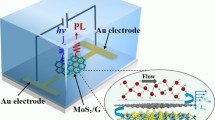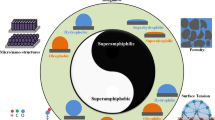Abstract
This study deals with the control of the movement of liquid droplets rolling down an inclined plate based on the differences in the wettability of the plate. We used a photoreactive polymer poly(7-methacryloyloxy coumarin) (PMC) whose molecular structure can be changed reversibly to realize different wettabilities by ultraviolet irradiation. We proposed employing sawtooth patterns at boundaries between areas with different contact angles to control the droplet trajectory. Furthermore, we experimentally observed that the droplet moves along a line inclined to the direction of gravity. The droplet behavior can be analyzed using a theoretical model based on the droplet dynamics wherein the surface tension acting on the contact line and the gravitational force are considered. The theoretical results suggest that inclination from the gravitational direction can be increased if the advancing contact angle is reduced. In the experiments conducted herein, ultrasonic vibration was applied to the inclined plate to reduce the contact angle hysteresis. The results showed that the advancing contact angle actually decreased and that the droplet trajectory was controlled to realize motion along a line with inclination angle almost twice of that realized without vibration.
Graphical abstract
A saw-tooth pattern of boundary between the areas with different contact angles was proposed to control the trajectory of a droplet rolling down on an inclined plate. As shown in the right figure, the droplet immediately diverges from the direction of gravity and moves in accordance with the target lines.











Similar content being viewed by others
Abbreviations
- B :
-
Maximum width of a droplet [m]
- F :
-
Vector of the force applied to a droplet [N]
- g :
-
Gravitational acceleration [m/s2]
- m :
-
Ratio of straight part of contact line to the radius of the arc-like contact line [-]
- R :
-
Radius of arc-like contact line [m]
- V :
-
Liquid volume [m3]
- x :
-
Coordinate on the plate surface in the direction of gravity [m]
- y :
-
Coordinate on the plate surface in transverse direction [m]
- α (= 45°):
-
Oblique angle of the UV-irradiated area in Pattern A [°]
- β :
-
Inclination angle of moving droplet [°]
- δ :
-
Variation in the contact angle [°]
- η :
-
Center angle of the arc-like contact line (advancing side, ref. Fig. 4) [°]
- θ :
-
Contact angle [°]
- µ :
-
Target inclination angle of droplet movement [°]
- ρ :
-
Liquid density [kg/m3]
- σ :
-
Surface tension [N/m]
- φ :
-
Inclination angle of the test plate [°]
- ψ :
-
Center angle of the arc giving the receding contact angle (receding side, ref. Fig. 4) [°]
- ′:
-
UV-irradiated
- A :
-
Advancing
- R :
-
Receding
- x :
-
Gravity direction on the plate surface
- y :
-
Transverse direction on the plate surface
References
Abdelgawad M, Park P, Wheeler R (2009) Optimization of device geometry in single-plate digital microfluidics. J Appl Phys 105:094506. https://doi.org/10.1063/1.3117216
Abgrall P, Gué AM (2007) Lab-on-chip technologies: making a microfluidic network and coupling it into a complete microsystem—a review. J Micromech Microeng 17:R15–R49. https://doi.org/10.1088/0960-1317/17/5/R01
Agapov RL, Boreyko JB, Briggs DP, Srijanto BR, Retterer ST, Collier CP, Lavrik NV (2014) Length scale selects directionality of droplets on vibrating pillar ratchet. Adv Mater Interfaces 1:1400337. https://doi.org/10.1002/admi.201400337
Bhaumik SK, Das S, Chakraborty S, Das Gupta S (2014) Droplet transport through dielectrophoretic actuation using line electrode. Microfluid Nanofluidics 16:597–603. https://doi.org/10.1007/s10404-013-1242-5
Chen JZ, Troian SM, Darhuber AA, Wagner S (2005) Effect of contact angle hysteresis on thermocapillary droplet actuation. J Appl Phys 97:014906. https://doi.org/10.1063/1.1819979
Darhuber AA, Troian SM (2005) Principles of microfluidic actuation by modulation of surface stresses. Annu Rev Fluid Mech 37:425–455. https://doi.org/10.1146/annurev.fluid.36.050802.122052
Datta S, Das AK, Das PK (2015) Uphill movement of sessile droplets by electrostatic actuation. Langmuir 31:10190–10197. https://doi.org/10.1021/acs.langmuir.5b02184
Dong Y, Holmes HR, Böhringer KF (2017) Converting vertical vibration of anisotropic ratchet conveyors into horizontal droplet motion. Langmuir 33:10745–10752. https://doi.org/10.1021/acs.langmuir.7b02504
Fobel R, Fobel C, Wheeler AR (2013) Dropbot: an open-source digital microfluidic control system with precise control of electrostatic driving force and instantaneous drop velocity measurement. Appl Phys Lett 102:193513. https://doi.org/10.1063/1.4807118
Gupta S, Ramesh K, Ahmed S, Kakkar V (2016) Lab-on-chip technology: a review on design trends and future scope in biomedical applications. Int J Bio-Sci Bio-Technol 5:311–322. https://doi.org/10.14257/ijbsbt.2016.8.5.28
Higashine M, Katoh K, Wakimoto T, Azuma T (2008) Profiles of liquid droplets on solid plates in gravitational and centrifugal fields. J JSEM 8(Special Issue):49–54. https://doi.org/10.11395/jjsem.8.s49
Hutama TJ, Oleschuk RD (2017) Magnetically manipulated droplet splitting on a 3D-printed device to carry out a complexometric assay. Lab Chip 17:2640–2649. https://doi.org/10.1039/C7LC00629B
Jain V, Devarasetty V, Patrikar R (2017) Effect of electrode geometry on droplet velocity in open EWOD based device for digital microfluidics applications. J Electrost 87:11–18. https://doi.org/10.1016/j.elstat.2017.02.006
Karapetsas G, Chamakos NT, Papathanasiou AG (2017) Thermocapillary droplet actuation: effect of solid structure and wettability. Langmuir 33:10838–10850. https://doi.org/10.1021/acs.langmuir.7b02762
Katoh K, Higashine M, Nakamoto N, Azuma T (2006) On the sliding down of liquid drops on inclined plates (1st report, Critical inclination angle of plates). Trans Jpn Soc Mech Eng Ser B 72:1287–1294. https://doi.org/10.1299/kikaib.72.1287
Katoh K, Wakimoto T, Masuda R (2010) A new method to actuate a droplet on a plate by use of laser and ultrasonic oscillation. Trans Jpn Soc Mech Eng Ser B 76:2135–2142. https://doi.org/10.1299/kikaib.76.772_2135
Katoh K, Tamura H, Sato E, Wakimoto T (2016) Control of droplet movement on an inclined wall by difference of wettability. Jpn J Multiph Flow 29:451–459. https://doi.org/10.3811/jjmf.29.451
Lahoon S, Rio OI, Cheng P, Neumann AW (1996) Axisymmetric drop shape analysis (ADSA). In: Neumann AW, Spelt JK (eds) Applied surface thermodynamics surfactant science Series 63, pp 441–508, CRC Press, Boca Raton
Lee JL, Lee S, Kang KH (2012) Droplet jumping by electrowetting and its application to the three-dimensional digital microfluidics. Appl Phys Lett 100:081604. https://doi.org/10.1063/1.3688487
Li W, Lynch V, Thompson H, Fox MA (1997) Self-assembled monolayers of 7-(10-Thio- decoxy)coumarin on gold: synthesis, characterization, and photodimerization. J Am Chem Soc 119:7211–7217. https://doi.org/10.1021/ja970633m
Lu HW, Glasner K, Bertozzi AL, Kim CJ (2007) A diffuse interface model for electrowetting drops in a Hele–Shaw cell. J Fluid Mech 590:411–435. https://doi.org/10.1017/S0022112007008154
Morrison H, Curtis H, McDowell T (1966) Solvent effects on the photodimerization of coumarin1. J Am Chem Soc 88:5415–5419. https://doi.org/10.1021/ja00975a009
Nahar MM, Nikapitiya JB, You SM, Moon H (2016) Droplet velocity in an electrowetting on dielectric digital microfluidic device. Micromachines 7:71. https://doi.org/10.3390/mi7040071
Obi M, Morino S, Ichimura K (1999) Factors affecting photoalignment of liquid crystals induced by polymethacrylates with coumarin side chains. Chem Mater 11:656–664. https://doi.org/10.1021/cm980533v
Pratap V, Moumen N, Subramanian RS (2008) Thermocapillary motion of a liquid drop on a horizontal solid surface. Langmuir 24:5185–5193. https://doi.org/10.1021/la7036839
Sato E, Nagai S, Matsumoto A (2012) Reversible volume changes of polymer thin films and their application to wettability control. In: 8th coatings science international conference book of abstracts, pp 83–86
Sato E, Nagai S, Matsumoto A (2013) Reversible thickness control of polymer thin films containing photoreactive coumarin derivative units. Prog Org Coat 76:1747–1751. https://doi.org/10.1016/j.porgcoat.2013.05.010
Shastry A, Case MJ, Böhringer KF (2006) Directing droplets using microstructured surfaces. Langmuir 22:6161–6167. https://doi.org/10.1021/la0601657
Suzuki K, Homma H, Murayama T, Fukuda S, Takanobu H, Miura H (2010) Electrowetting-based actuation of liquid droplets for micro transportation systems. J Adv Mech Des Syst 4:365–372. https://doi.org/10.1299/jamdsm.4.365
Volpe CD, Maniglio D, Morra M, Siboni S (2002) The determination of a ‘stable-equilibrium’ contact angle on heterogeneous and rough surfaces. Colloids Surf A Physicochem Eng Asp 206:47–67. https://doi.org/10.1016/S0927-7757(02)00072-9
Wakimoto T, Sato Y, Katoh K (2013) A new method to actuate a droplet on a plate by use of laser irradiation to improve wettability. J JSEM 13:19–26. https://doi.org/10.11395/jjsem.13.19
Xi HD, Zheng H, Guo W, Gañán-Calvo AM, Ai Y, Tsao CW, Zhou J, Li W, Huang Y, Nguyenh NT, Tan SH (2017) Active droplet sorting in microfluidics: a review. Lab Chip 17:751–771. https://doi.org/10.1039/C6LC01435F
Yeo LY, Friend JR (2014) Surface acoustic wave microfluidics. Annu Rev Fluid Mech 46:379–406. https://doi.org/10.1146/annurev-fluid-010313-141418
Zhang Y, Nguyen NT (2017) Magnetic digital microfluidics—a review. Lab Chip 17:994–1008. https://doi.org/10.1039/C7LC00025A
Zhao Y, Liu F, Chen CH (2011) Thermocapillary actuation of binary drops on solid surfaces. Appl Phys Lett 99:104101. https://doi.org/10.1063/1.3632041
Acknowledgements
A part of this research was supported by Japan Society for the Promotion of Science (JSPS) Grant Number 15K05802.
Author information
Authors and Affiliations
Corresponding author
Additional information
Publisher’s Note
Springer Nature remains neutral with regard to jurisdictional claims in published maps and institutional affiliations.
Electronic supplementary material
Below is the link to the electronic supplementary material.
Supplementary material 1 (MP4 598 KB)
Rights and permissions
About this article
Cite this article
Katoh, K., Tamura, H., Sato, E. et al. Control of droplet movement on an inclined wall with sawtoothed wettability pattern by applying ultrasonic vibration. Exp Fluids 59, 141 (2018). https://doi.org/10.1007/s00348-018-2592-2
Received:
Revised:
Accepted:
Published:
DOI: https://doi.org/10.1007/s00348-018-2592-2




